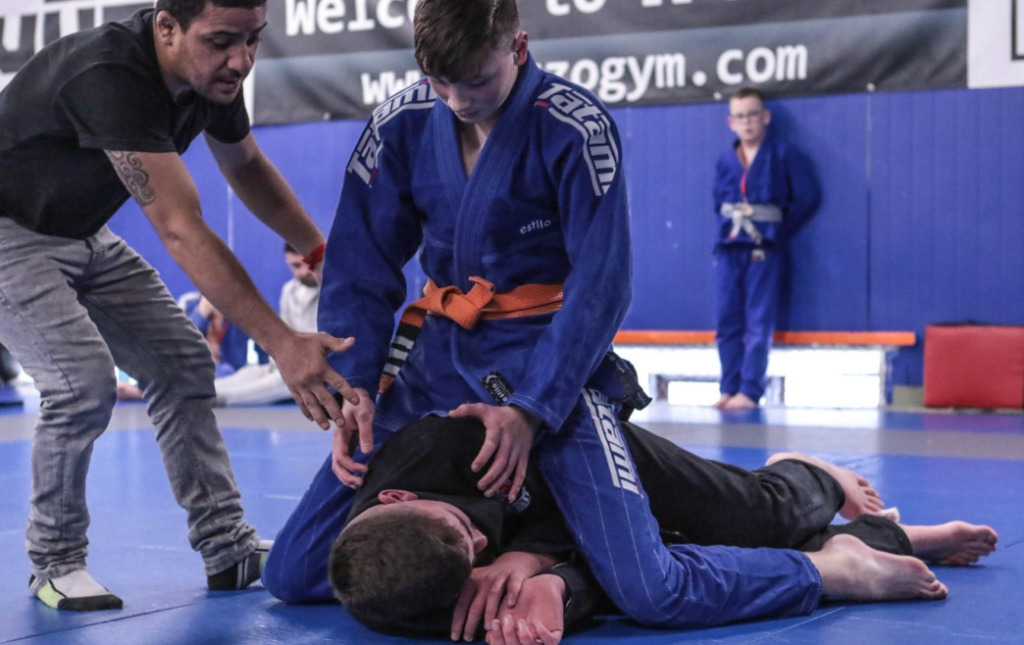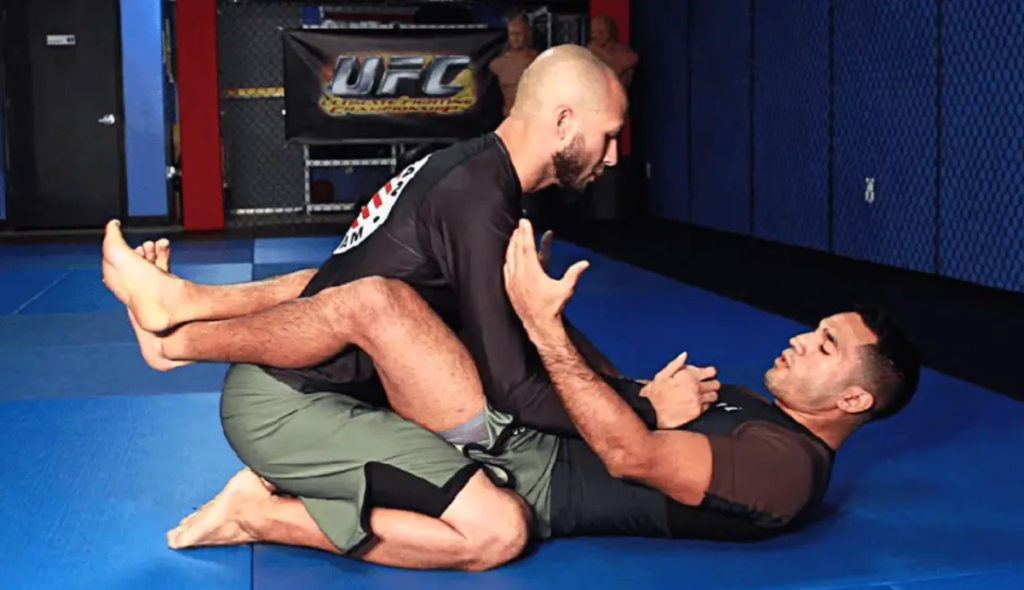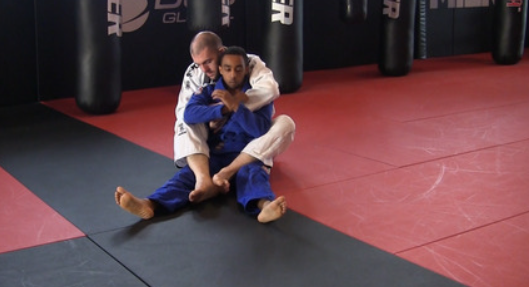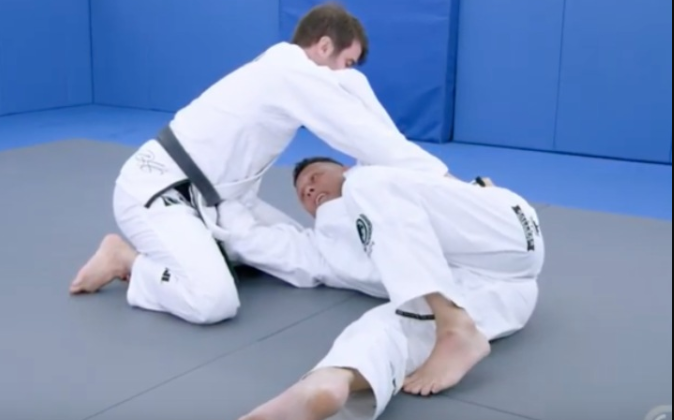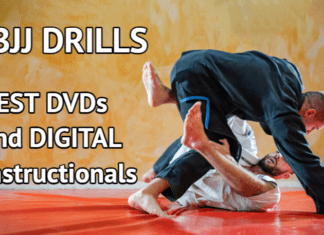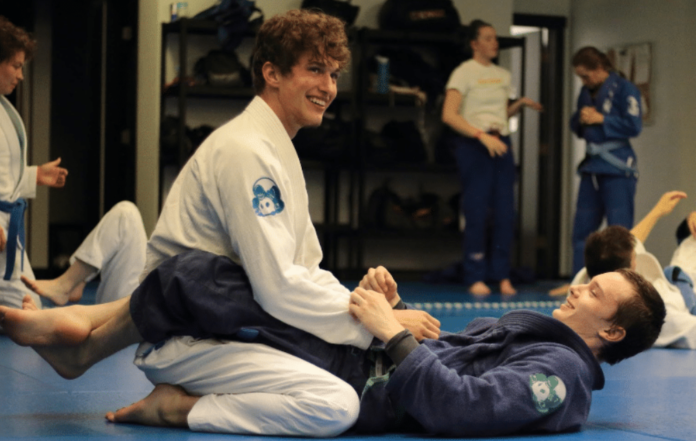
Brazilian Jiu-Jitsu is a martial art that focuses on grappling and ground fighting. It is based on the principle that a smaller and weaker person can defeat a larger and stronger opponent by using leverage, technique, cunning, and submissions.
But how do you get to a position where you can apply those submissions? And how do you prevent your opponent from doing the same to you?
That’s where the positions in BJJ come in.
The positions in BJJ are the building blocks of the art, as they allow you to control your opponent, attack or defend yourself, and escape from danger. Knowing the basic positions in BJJ and how to transition between them is essential for improving your skills and performance on the mat.
In this article, we will cover the basic BJJ positions, such as the guard position, the full mount position, the side control position, and the back control position. We will also explain which are the only ones you need, and how to focus on perfecting them both as a beginner and intermediate Jiu-Jitsu practitioner.
You actually need a lot less than you think you do to be successful at all levels in the sport of Brazilian Jiu-Jitsu.
By the end of this article, you will have a solid understanding of the positional hierarchy in Jiu-Jitsu and how to use only three positions in BJJ to gain an advantage over anyone, rather than having to deal with many positions and variations and end up confused.
Let’s get started!
The Guard(s)
The guard refers to all those positions in BJJ where you are on your back and you have your legs in between you and your opponent. It is one of the most common and versatile basic Jiu-Jitsu positions, as it allows you to attack with sweeps, submissions, and transitions while preventing your opponent from passing your legs and gaining a dominant top position.
There are many variations of the guard, but at the end of the day there are only two that matter :
- Closed guards: the full guard, where you lock your ankles behind your opponent’s back and the half guard position where you lock your legs around an opponent’s thigh, being the most obvious ones, and
- Open guard: tens, if not hundreds of positional variations where you don’t lock your ankles but use your feet to control your opponent’s hips, knees, ankles, or upper body. Examples include the butterfly guard, the spider guard, the De La Riva guard, X Guard, and many more.
Each type of guard has its own characteristics, advantages, and disadvantages. The closed guards offer better control and make it a lot more difficult for the top person to break out. Open guards are more offensive but offer a lot less positional stability.
Closed Guard Tactics for Brazilian Jiu-Jitsu White and Blue Belts
Focus on the closed guard. Your A game should be keeping people in the closed guard without fatiguing, and aiming to get a submission, sweep, or the back from there. Gi or No-Gi, versus peers, more advanced or less experienced training partners, you should develop a killer closed guard at this level that is impervious to any guard pass.
Since nothing in Jiu-Jitsu works perfectly all the time, your plan B should be the half guard. And yes, closed half-guard variations like the Z-guard and lockdown should be your go-to.
The goal is to use plan B to get back to plan A (full guard) or launch an offensive barrage directly.
Closed Guard Tactics for Brazilian Jiu-Jitsu Purple and Brown Belts
While experimenting with the guard is usually what purple belts do, the advice here is to stick to closed variations.
By all means, have your fun with crazy inverted guards, Matrixes, lasso guard, and other lapel bondage. However, the foundation of your guard game needs to be closed-guard variations. Full guard, Williams guard, high guard, rubber guard, Octopus guard and every other crazy variation that falls under closed guard positions in BJJ should be plan A.
Plan B, similar to beginners, should include half guard. In this instance, however, you can mess around with other variations as well. For example, you can include half-closed guards like the butterfly half guard, or the fishnet half guard.
Also, keep in mind that you can use closed-guard tactics from positions many people associate with open guards, like the 50/50, Reverse De la Riva (the RDLR lockdown), and others to prevent guard passing.
At black belt, you should already have a very solid understanding of closed guards and can have fun with open variations enjoying the safety of your A (and B) game.
To have a good guard, you need to be active and dynamic. You should constantly adjust your angle, grip fighting, and distance to create openings for attacks or transitions. You should also use your legs as hooks, levers, and frames to control your opponent’s movement and balance.
Some of the very best in the sport, like Roger Gracie, Braulio Estima, Gordon Ryan, etc all have incredible closed guards. It is all you need from the bottom.
The Mount
The mount is a grappling position where you are on top of your opponent’s chest or abdomen, with your knees on either side of their hips. It is one of the most dominant positions in Jiu-Jitsu, as it gives you a lot of leverage and power to attack with submissions (or strikes in MMA(mixed martial arts) while limiting your opponent’s ability to escape or defend.
There are several variations of mount positions in BJJ, such as:
- Low mount: where you keep your hips low and hug your opponent’s body
- High mount: where you slide your knees up and isolate your opponent’s arms
- The S-mount: where you turn one knee up and sit on your opponent’s chest
- Technical mount: where you follow your opponent’s movement and switch sides or take their back
Each type of mount has its own benefits and drawbacks. For example, the S-mount offers incredible attacking options but lacks stability and mobility that are essential to remaining on top, which in some cases, might be a lot more important than submitting someone.
The low mount, on the other hand, is extremely good for maintaining stability and pressure, but it reduces your range of motion and attack options. The technical mount is optimal for following your opponent’s movement and transitioning to take their back.
Mount Tactics for Brazilian Jiu-Jitsu White and Blue Belts
When it comes to fundamental positions in BJJ, you will end up on the receiving end of the mount, or on the controlling end everytime you roll and in most cases during competition matches.
As a beginner, the low mount should be your only priority. Keep your hips at the belt level of your opponent, pin their arms above their head, and practice how to be heavy and keep people on the bottom, while making their lives miserable. You can’t do enough reps of mount control regardless of your belt and experience level.
The goal as a beginner is to stay in the mount, rather than rush to submissions. Plan B is to transition to the back and figure out how to loop these two positions together so that you never lose control.
Mount Tactics for Brazilian Jiu-Jitsu Purple and Brown Belts
This is where mount positions in BJJ get confusing for people. You can control someone from the mount, but you lose it all when you try to go for a submission. Or, you can submit someone from mount, but only if you set that submission up immediately, as opposed to spending some time on top of your opponent.
As an intermediate/advanced grappler, you can shift between different mount positions in BJJ, keeping in mind that you can only practice submissions once you master the transition, and more importantly, the controlling mechanics of all mount variations, from low mount to the Monkey mount.
Similar to guards, black belts can take their mount in any direction they desire, provided they have a good foundation with the basic Jiu-Jitsu mount variations.
To have a good mount, you need to learn to be heavy and stay tight. You should use your hips and legs to create pressure and friction on your opponent’s chest and hips. Also, make sure to use your arms, head, and upper body to control the opponent’s head and shoulders.
Finally, you should always be ready to adjust your position according to your opponent’s reaction or resistance.
Roger Gracie, Gordon Ryan, and Buchecha are great examples of people with terrifying mounts.
The Back Control (Back Mount)
The back control is an extremely powerful position where you are behind your opponent, with both hooks (legs) inside their thighs and both arms around the opponent’s torso. It is arguably the most advantageous position in Jiu-Jitsu, as it gives you full access to attack the opponent’s neck with chokes or their arms with different joint locks while making it very hard for them to escape or defend.
There are different types of back control depending on how you control the hips and shoulders. The seatbelt and Straight Jacket are the most popular ones for upper body control.
The body triangle, straight hooks, and post rear mount are the best lower body controlling options from the back mount position.
The back mount offers immense control and some of the highest percentage finishing techniques, like the rear naked choke and the bow and arrow choke.
Back Control Tactics for Brazilian Jiu-Jitsu White and Blue Belts
Stay in back control. Try not to rely too much on the body triangle, but rather experiment with straight hooks and the post rear mount position (both hooks on one side). The Straight jacket is the absolute best of the back mount positions in BJJ for the upper body, but going old-school with the seatbelt grip is also going to be useful.
Your goal is to remain on the opponent’s back, like the most annoying backpack in the world, and prevent them from turning their chest towards yours. Once again, refrain from submissions for as long as you can, focusing on keeping people from figuring a way out of your back mount.
The plan B is to transition to the mount, as we already discussed in the previous section.
Back Control Tactics for Brazilian Jiu-Jitsu Purple and Brown Belts
As a more advanced grappler, you can focus on playing around with different back mount positions in BJJ, and start focusing on only controlling the hips or shoulders. An example of hip control is the truck position, while upper body examples include the crucifix and/or rear triangle position.
Threatening with more than one avenue of attack is going to open up more finishing options, allowing you to finish a higher percentage of your submission attempts. Focus on grip variations like the Gift Wrap that allow you to control both the mount and the back mount without having to adjust too much.
As a black belt understanding control and how to diffuse your submissions, you can mess around with cool entries to the back mount like Berimbolos or twister rolls.
To have good back control, you need to be tight and patient. Use your hooks and hips to keep your opponent close and prevent them from turning into you or shaking you off. You should also use your arms and head to control your posture and eventually expose their neck for chokes.
Finally, you should always be patient and opportunistic, and wait for them to make a mistake or give up an opening.
You; ‘ll notice that the same names appear as examples of people with some of the best back mount games in BJJ history: Gordon Ryan, Roger Gracie, and Marcelo Garcia, to mention but a few.
What About Side Control?
Side control is a position where you are on top of your opponent’s side, with one arm under their head and the other arm under their far arm. It is another one of the common top positions in BJJ, as it allows you to control your opponent’s upper body and attack with submissions from different angles.
Sid control, however, is not as nearly a dominant position in the same manner as the mount, back mount, and closed guard are. It is more of a neutral position since the bottom person has lots of options too.
The main reason we are not including side control among the advantageous positions you need in BJJ is that it is too dynamic and leaves the hips of the person in bottom position fairly free to either move, or stay passive, but in a powerful defensive position that will make all attacks obsolete. This makes it a less dominant position compared to mount and back.
There are many variations of side control (Kesa Gatame scarf hold, Twister side control, North-South, etc) and they all require you to have a detailed expert understanding of weight distribution, body positioning, timing, etc, which are black belt traits.
To have good side control, you need to be mobile and adaptive, constantly switching between different types of side control to confuse your opponent and create opportunities for attacks or transitions. You should also use your weight and shoulder pressure to pin down your opponent and prevent them from creating space or frames.
As a white or blue belt, this is too much to try and figure out, especially when you need to consider that you have the mount, back mount, and guard to learn as well.
As a more advanced grappler, you should focus on submitting people from the aforementioned trio of positions and shift effortlessly between the three of them. Landing in side control or knee on belly briefly is going to happen, but there is no need to try and focus on such a highly variable control position that offers inferior control to the three positions in BJJ that give you the most bang for your buck: closed guard(s) mount and back mount.
Conclusion
In this article, we have covered the only three positions in BJJ that you’ll ever need to be successful in the grappling arts: the closed guard(s), the mount, and back control. We have also explained how to transition between them and what are the advantages and disadvantages of each strong position.
Most importantly we gave you a blueprint about what to focus on at different belt levels in terms of the best controlling positions in BJJ.
Learning as much as you can about these positions in BJJ is essential for improving your skills and performance on the mat. Practice them regularly with different partners and scenarios to develop your muscle memory and creativity.
Remember that the positions in BJJ are not static or fixed, but dynamic and fluid. You should always adapt to the situation and use the best position for each moment.
If you want to learn more about positional control in your Jiu-Jitsu journey and how to improve your game, check out our other articles on:










